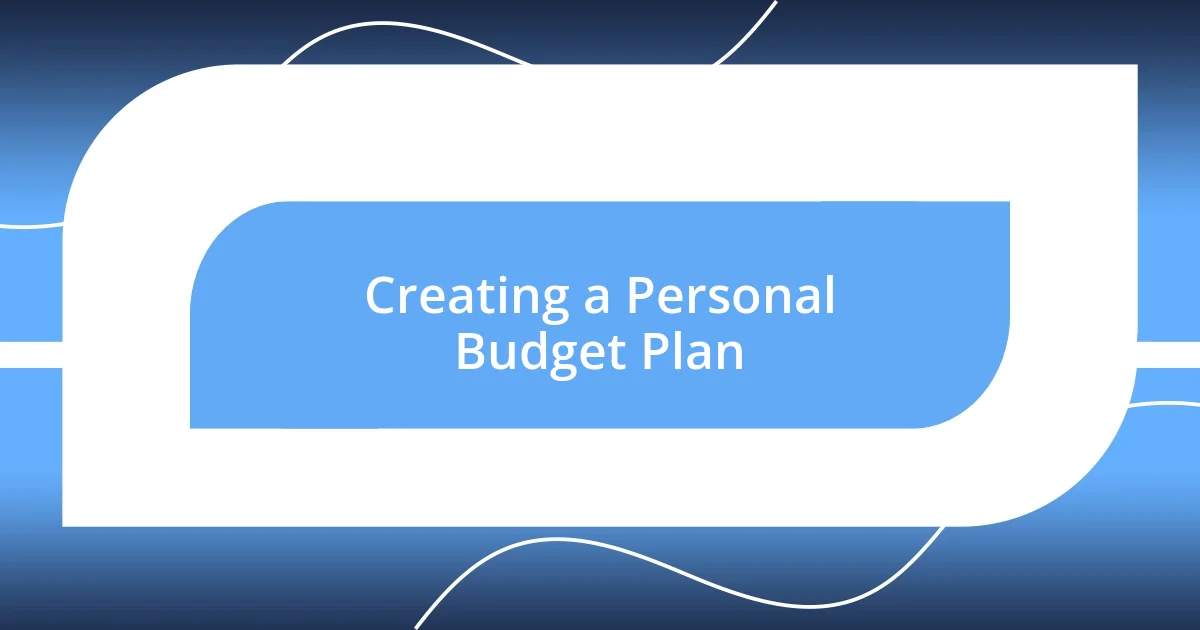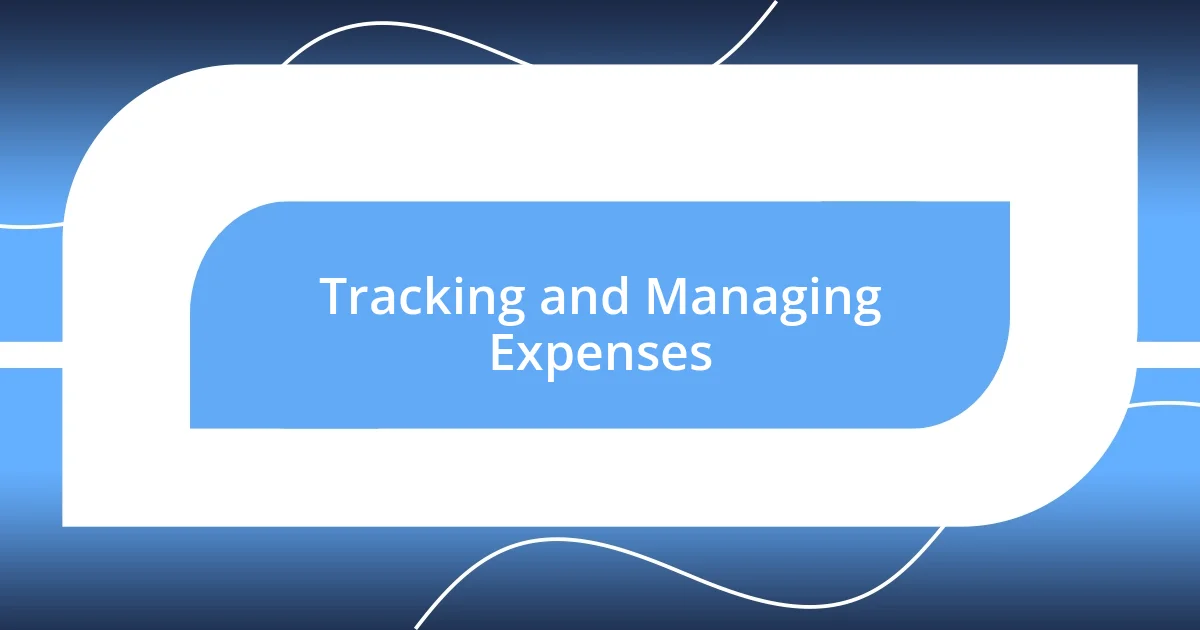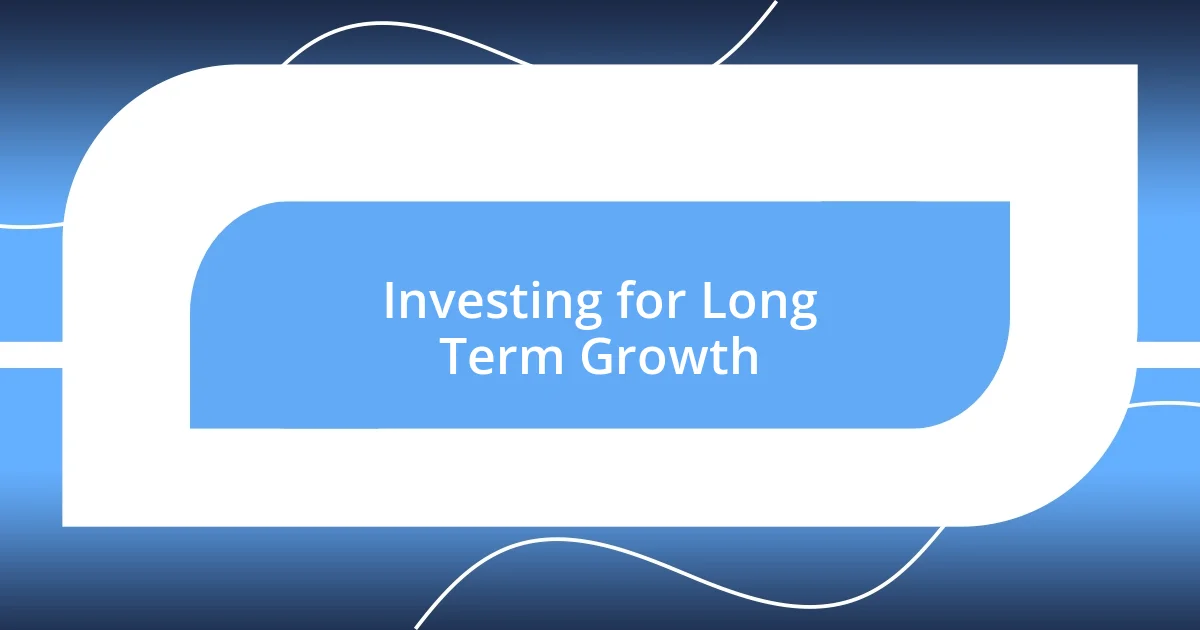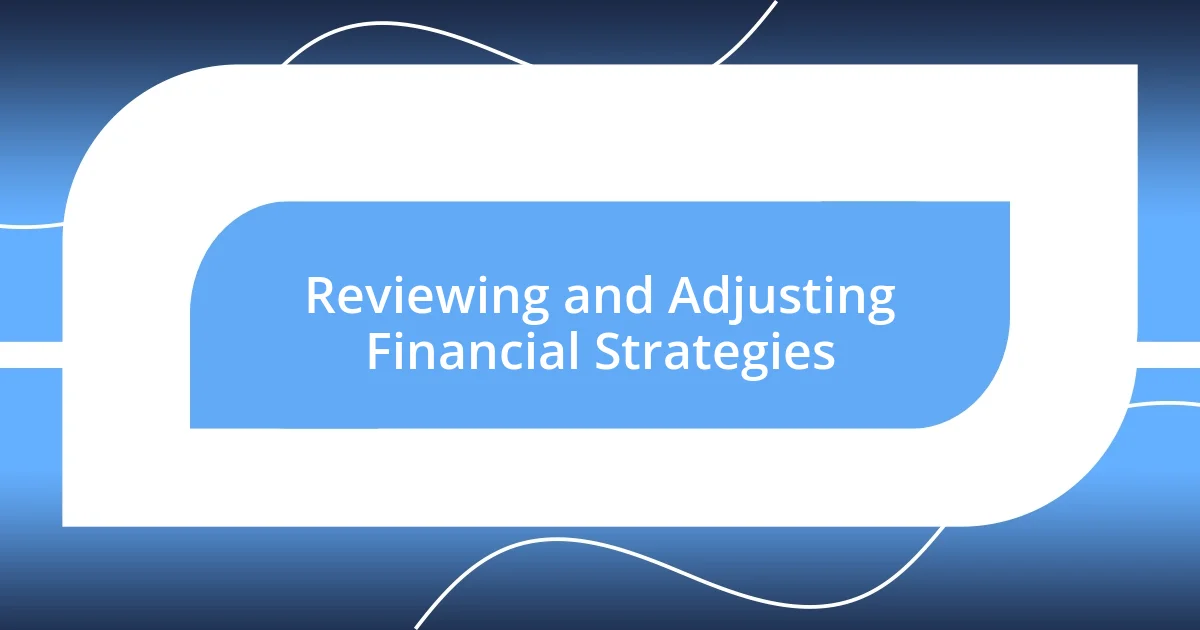Key takeaways:
- Understanding the distinction between needs and wants is crucial for effective budgeting and financial management.
- Setting SMART financial goals (Specific, Measurable, Achievable, Relevant, Time-bound) significantly enhances progress and motivation.
- Regularly reviewing and adjusting financial strategies helps adapt to life changes and improves overall financial health.

Understanding Personal Finance Basics
When I first dove into personal finance, I was overwhelmed by the sheer amount of information out there. I remember sitting at my kitchen table, cash spread out, trying to grasp the concepts of budgeting and saving. It dawned on me that understanding where my money was going was the first step in taking control – and isn’t it liberating to finally know where your funds are allocated?
One thing that really struck me while learning about personal finance was the idea of distinguishing between needs and wants. It wasn’t until I reflected on my late-night online shopping habits that I realized how easy it is to confuse the two. Have you ever bought something you thought you needed, only to find it collecting dust a few months later?
The basics of personal finance also include understanding debt, which can be a tricky landscape to navigate. I’ll never forget when I faced my first credit card bill—seeing that number made my heart race. That fear pushed me to educate myself about interest rates and repayment strategies. Now, I view such responsibilities as stepping stones to financial freedom rather than burdens. How do you feel when you think about your financial obligations?

Setting Financial Goals Effectively
Setting financial goals effectively transformed my approach to money management. Initially, I set vague targets—like “save more” or “worry less.” It wasn’t until I learned about the SMART criteria—Specific, Measurable, Achievable, Relevant, Time-bound—that I began to see real progress. For example, instead of just wanting to save money, I set a goal to save $5,000 for a vacation within a year. This clarity made all the difference; it was like switching on a light in a dim room.
To ensure your financial goals resonate and stay on track, consider these practical steps:
- Define specific goals: Clearly state what you want to achieve, like buying a home or paying off debt.
- Break them down: Divide larger goals into smaller, manageable tasks—this makes the journey less daunting.
- Set deadlines: Establish timelines to create accountability—it’s easier to stay motivated when you have a target date.
- Regularly review and adjust: Life changes, and so can your goals; adapt them as needed to stay aligned with your values and circumstances.
- Celebrate milestones: Recognizing your progress, no matter how small, keeps the motivation alive and reinforces positive behaviors.
Reflecting on my own experience, I vividly remember when I successfully saved for that first big purchase—it felt like a true victory. Each step made me more confident in my ability to reach my financial aspirations.

Creating a Personal Budget Plan
Creating a personal budget plan was a pivotal moment in my financial journey. I remember feeling a mix of excitement and anxiety as I crafted my first budget. It was like building a map for my finances, laying out income and expenses in a way that made everything clearer. I used a simple spreadsheet, listing all my sources of income on one side, while categorizing my expenses on the other, and seeing it all laid out helped me spot areas where I could cut back. Have you ever felt the weight lifted off your shoulders as you realized where you could save?
As I fine-tuned my budget, I found it helpful to implement the 50/30/20 rule. This guideline suggests allocating 50% of your income to essentials, 30% to discretionary spending, and 20% to savings and debt repayment. It resonated with me because it offered a balanced approach, preventing me from feeling overly restricted. I recall how challenging it was at first; adjusting my lifestyle felt like learning to ride a bike. But once I got the hang of it, I started feeling more in control of my choices, paving the way for smarter financial decisions.
One key takeaway from my budgeting experience is the importance of flexibility. Life is unpredictable, and while having a budget is essential, adapting it as necessary can be equally crucial. I once had a major car repair that threw my budget for a loop, but instead of panicking, I adjusted my discretionary spending for the month. That moment taught me resilience and the ability to pivot when unexpected expenses arise. How has flexibility in your budget guided your financial management?
| Aspect | My Approach |
|---|---|
| Initial Budget Setup | Spreadsheet with income and expenses |
| Budgeting Method | 50/30/20 rule |
| Adaptability | Adjust as needs change |

Tracking and Managing Expenses
Tracking my expenses transformed the way I viewed my financial life. At first, I thought it would be tedious, but it quickly became an enlightening experience. I started by using a mobile app to log every purchase, which made my spending habits transparent. Have you ever been surprised by how much those daily coffee runs add up? I sure was! Seeing the numbers laid out before me compelled me to question my choices and make some necessary adjustments.
Once I became more aware of my spending, I found that it wasn’t just about cutting back—it was about making conscious choices. I began categorizing my expenses into needs and wants, which helped me prioritize. For instance, I realized that while I loved dining out, I could save by opting for more home-cooked meals. Each time I cooked instead of hitting a restaurant, it felt like both a small victory and a step toward my financial goals. Have you noticed how small changes can lead to significant savings over time?
The act of reviewing my expenses regularly has also been incredibly empowering. Setting aside time each month to go over my spending not only kept me accountable, but it also allowed me to celebrate my successes. For example, when I saw I had saved more than I anticipated, I felt a rush of excitement. I began using those savings toward fun experiences—like that trip to the beach I had been dreaming about. How does tracking your expenses make you feel about your financial journey? I find that the more I engage with my spending, the more control I gain. It isn’t just about managing money; it’s about living life on my terms.

Building an Emergency Fund
Building an emergency fund has been one of the most empowering steps I’ve taken in my financial journey. Initially, I felt overwhelmed by the idea of saving a few months’ worth of expenses, but I started small. Even saving just a little each month added up faster than I expected, and the first time I hit the $1,000 mark, I could hardly believe it.
I made a commitment to prioritize this fund, treating it like a non-negotiable bill. Each payday, I would transfer a set amount into a high-yield savings account, separate from my everyday spending. Watching that number grow was a thrilling experience—I remember the satisfaction of knowing I could handle unforeseen events like car repairs or medical bills without going into debt. Have you ever experienced that reassuring feeling of financial security? It’s like having a safety net that allows you to live your life without constant worry.
One of the most surprising lessons I learned was how motivating it could be to visualize my goal. I created a simple chart on my wall, marking my progress as my emergency fund grew. Each time I updated it with a new milestone, I felt a rush of accomplishment. It transformed saving from a chore into a rewarding challenge. Have you tried tracking your savings in a way that excites you? It definitely kept me engaged and committed, proving that a little creativity can ignite motivation in the journey toward financial stability.

Investing for Long Term Growth
Investing for long-term growth has been a game-changer for my financial mindset. I remember the first time I dipped my toes into the stock market. It felt daunting, but I quickly realized that investing isn’t just about buying shares; it’s about believing in the companies you invest in and watching your money work for you over time. You ever feel that rush when you see your investments gradually increase? It’s both thrilling and rewarding.
I started with index funds, which I found to be a low-cost way to gain exposure to a diversified portfolio. By keeping my emotions in check and focusing on the long horizon, I learned to ride out market fluctuations instead of panicking over temporary downturns. Have you ever experienced that moment of doubt when the market dips? I certainly have, but holding onto those investments has often resulted in significant returns. I know that patience truly pays off in the world of investing.
Diversification has also played a crucial role in my investment strategy. By spreading my investments across various sectors, I felt more secure knowing that a downturn in one area wouldn’t derail my entire portfolio. I vividly remember a few years back when a tech boom raised my portfolio’s value significantly, giving me an unexpected windfall. Have you thought about how varying your investments might offer a cushion during market volatility? For me, it transformed what used to feel like a gamble into a measured and strategic approach to building my wealth over time.

Reviewing and Adjusting Financial Strategies
Reviewing and adjusting financial strategies is critical as life and goals evolve. I recall a time when I was so focused on my monthly budget that I neglected to assess my investment goals. One day, I decided to sit down and review everything, and I realized that my priorities had shifted—what worked a year ago no longer aligned with my current situation. Have you ever felt the urge to tweak your financial game plan? It’s definitely worth the effort to reflect and recalibrate.
As I dove deeper into this process, I learned that regular check-ins can reveal areas for improvement in unexpected ways. I remember finding some subscriptions I no longer used that had steadily added up over months. Canceling them not only freed up funds but also motivated me to look elsewhere for savings opportunities. Have you taken the time lately to reassess your spending habits? Small adjustments can lead to surprisingly profound effects.
Moreover, adjusting my financial strategy often requires embracing flexibility. For instance, after a significant life event, I adjusted my savings targets, realizing that life isn’t static. I started allowing myself to shift priorities without guilt. Learning to adapt my financial strategies to my current reality has been liberating. How about you? When did you last allow yourself that freedom? Each adjustment has brought clarity, helping me identify what truly matters in my financial journey and reinforcing the importance of regular reviews.














